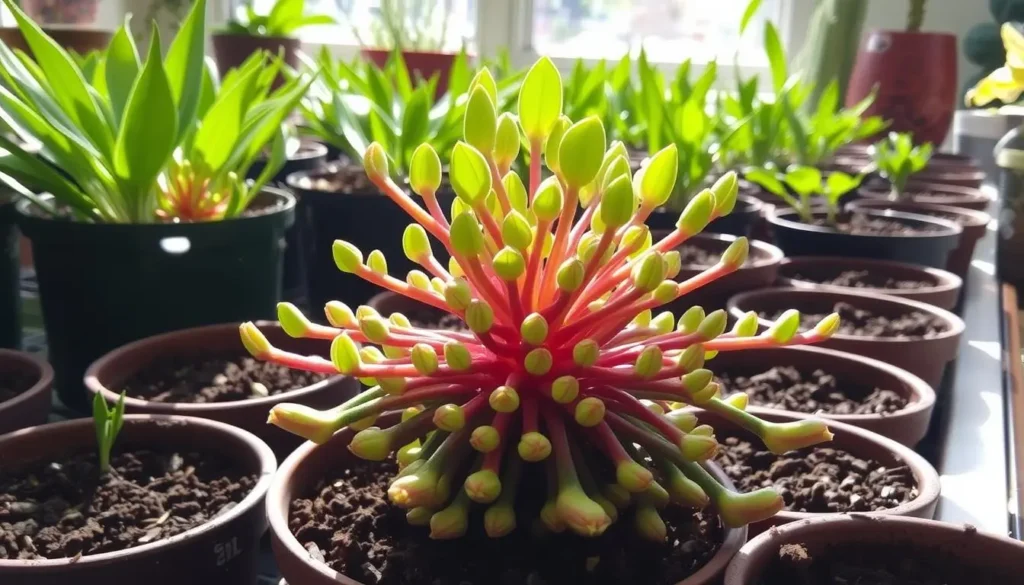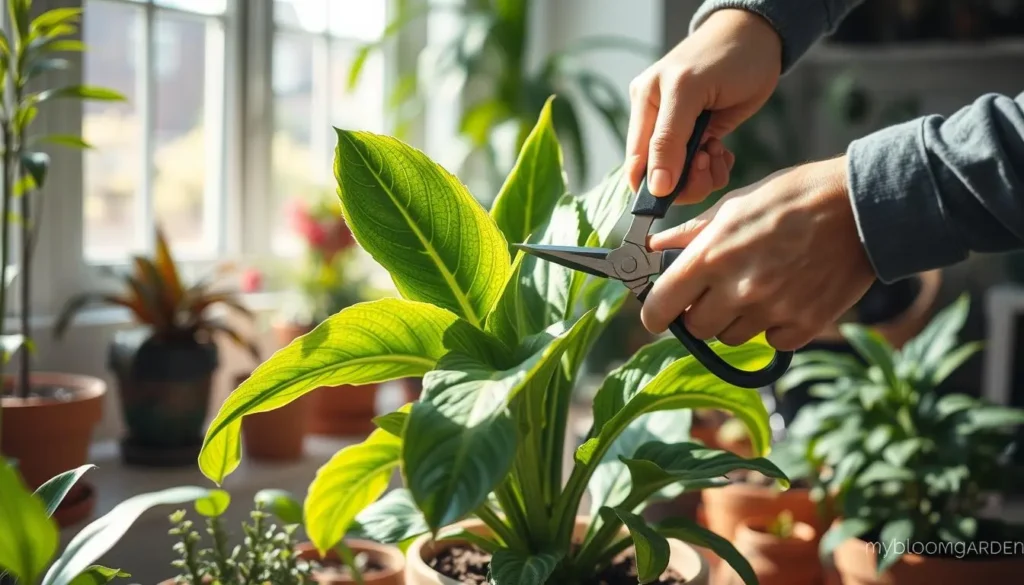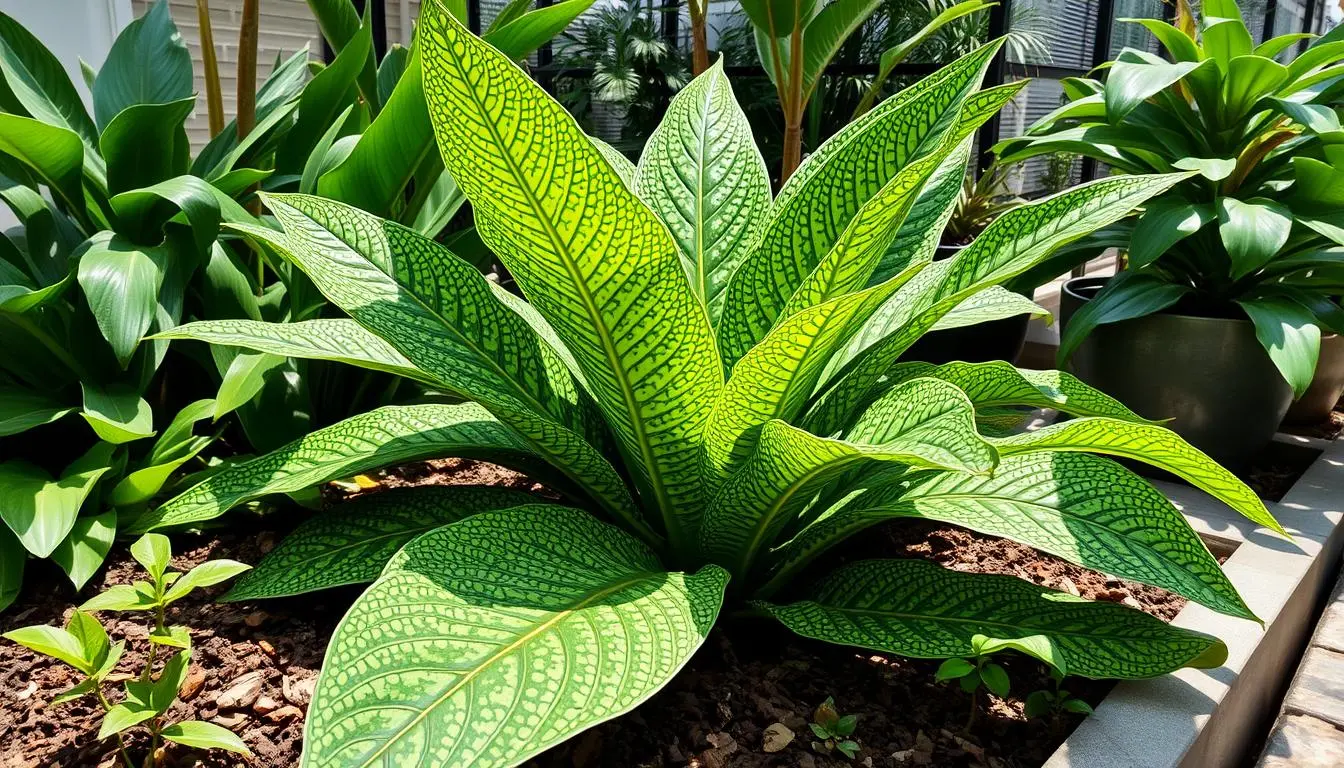The Alligator Plant, also known as the Mother of Thousands, brings a unique touch to your home. It’s a fascinating houseplant that can add joy to your space. I’ve cared for my Alligator Plant for years and feel a deep satisfaction watching it grow.
Today, I’m excited to share my knowledge with you. I’ll guide you through the key steps to grow this mesmerizing plant in your home.
Table of Contents
Understanding the Alligator Plant: Origins and Characteristics
The alligator plant, also known as the mother of millions or million plant, is a unique succulent from Madagascar. It has a rich history and interesting traits. These make it a favorite in homes and gardens.
Native Habitat and Natural Growth Patterns
In Madagascar, the alligator plant loves the warm, humid climate. It grows in rocky, well-draining spots, sticking to cliffs and boulders. It’s amazing how it thrives in tough places, spreading and forming thick colonies.
Physical Features and Plant Description
The alligator plant looks like its name suggests. Its fleshy, triangular leaves look like alligator scales. These leaves can be up to 6 inches long and have a reddish-purple color, especially at the edges. It also has small, pinkish-white flowers that bloom in clusters, making it even more beautiful.
Common Varieties and Types
There are many types of mother of millions, but the alligator plant is the most famous. Varieties like Bryophyllum daigremontianum, Bryophyllum fedtschenkoi, and Bryophyllum delagoense have similar traits. They all have the unique ability to grow plantlets along their leaves.
“The alligator plant is a fascinating and resilient succulent that has captured the hearts of plant enthusiasts around the world.”
Benefits of Growing Mother of Thousands in Your Home
Adding the alligator plant, also known as the mother of thousands, to your home has many perks. This tough and interesting succulent is great for indoor spaces. It offers benefits that make it a top pick for homeowners today.
One key alligator plant benefit is its ability to clean the air. It’s very good at removing toxins like formaldehyde and benzene. This helps make your indoor air healthier. It’s perfect for rooms with little air flow or where pollutants are common.
The mother of thousands is also known for being easy to care for. It does well with little water and attention. Its hardiness and flexibility make it great for people who are busy or new to plants. It ensures your indoor garden stays lively with little effort.
The mother of thousands also looks amazing. Its leaves, shaped like alligators or dragons, add fun and mystery to any area. It looks great on windowsills, shelves, or hanging baskets. This plant can make your home look better and spark interesting conversations.
“The mother of thousands is a true gem for the modern indoor gardener, offering a winning combination of air-purifying benefits, low-maintenance care, and captivating visual appeal.”
In summary, the alligator plant, or mother of thousands, is a versatile and rewarding choice for any home. It cleans the air, is tough, and looks striking. It’s a must-have for anyone wanting to improve their indoor space with a bit of natural beauty.
Essential Growing Requirements for Alligator Plant Success
To grow an alligator plant, also known as the alligator plant succulent, you need to know its needs. It needs the right light, temperature, humidity, and soil. This will help your alligator plant care be successful.
Light Requirements and Exposure
The alligator plant loves the sun. It needs bright, direct sunlight for at least 6 hours a day. Put it in a south or west window for the best light. If it’s too dark, use a grow light to help.
Temperature and Humidity Needs
The alligator plant does well in warm, dry places. It likes temperatures between 65°F and 85°F. Keep it away from cold drafts and sudden changes in temperature. It prefers a dry environment, so keep the humidity moderate.
Soil Type and Drainage Requirements
For the best alligator plant care, use a special soil mix for cacti and succulents. The soil should be slightly acidic to neutral pH. It should drain well, with perlite, sand, or pumice. Don’t use heavy soils that can cause waterlogging and root rot.
“Providing the right growing conditions is essential for the alligator plant to thrive and reach its full potential.”
Watering Schedule and Moisture Management
Proper watering is key for your overwatered mother of thousands. Finding the right balance between moisture is crucial. With the right approach, your alligator plant will thrive.
Understanding your plant’s needs is the first step. Alligator plants prefer well-draining soil and consistent moisture. But, they can’t handle too much water. Make sure the soil isn’t too dry or too wet.
- Establish a Watering Schedule: Water your overwatered mother of thousands every 7-10 days. Adjust as needed based on growth and environment.
- Check Soil Moisture: Use your finger to test the soil before watering. Water if the top inch is dry. Don’t water if it’s still moist.
- Adjust for Seasons: Water more often during the growing season. In winter, your plant needs less water.
It’s important to know the signs of too much or too little water. Wilting, yellowing leaves, and root rot mean too much water. Dry, crispy leaves need more moisture. Adjust your watering if you see these signs.
“The key to keeping your overwatered mother of thousands healthy is to maintain consistent soil moisture without letting it become waterlogged or completely dry.”
By following these tips and staying alert, you’ll learn to water your alligator plant well. This will ensure its long-term health.
Fertilizing Your Mother of Millions
The alligator plant, also known as the mother of millions, needs the right food to grow well. It’s important to feed it properly to keep it healthy and vibrant.
Best Fertilizer Types
Choose a balanced, water-soluble fertilizer that’s low in nitrogen for your alligator plant. A 10-10-10 or 12-12-12 ratio is good. Stay away from high-nitrogen fertilizers, as they can make the plant grow too much foliage and not enough flowers.
Seasonal Feeding Schedule
The mother of millions plant grows fast, so it needs regular food during the growing season. Feed it every 4-6 weeks in spring and summer. In fall and winter, when it grows slower, feed it once every 2-3 months.
Signs of Over and Under Fertilization
- Too much fertilizer can cause yellow leaves, slow growth, and even kill the plant. If you see these signs, stop feeding and wash the soil with water.
- Not enough fertilizer can make the plant grow slowly, have pale leaves, and not bloom. Stick to the recommended feeding schedule to keep your alligator plant happy and healthy.
Knowing the right fertilizer, when to feed, and how to tell if you’re feeding too much or too little will help your mother of millions plant thrive at home.
Propagation Methods and Techniques
Want to grow your own mother of thousands plant? Explore the world of propagation and learn to multiply this unique alligator plant easily. Whether you’re new to gardening or have experience, learning how to propagate mother of thousands opens up new possibilities.
The mother of thousands can grow tiny plantlets on its leaves’ edges. These plantlets are crucial for successful propagation. Just take a leaf from the mother plant, and watch as mini versions grow.
- Carefully remove a healthy leaf from the mother plant, ensuring you don’t damage the stem.
- Place the leaf on well-draining soil or a potting mix specifically formulated for succulents.
- Mist the leaf lightly, and keep the soil consistently moist (but not waterlogged) until the plantlets begin to form.
- Once the plantlets have established their own roots, gently separate them from the parent leaf and pot them up individually.
For quicker propagation, try stem cuttings from the mother plant. This method multiplies your alligator plant fast, creating a lush display quickly.
“Propagating the mother of thousands is an incredibly rewarding experience. Watching those tiny plantlets take root and grow into their own thriving plants is truly magical.”
With patience and care, you’ll soon have a collection of mother of thousands plants. Enjoy the joy of propagation and watch your alligator plant population grow!

Common Pests and Diseases
Starting your alligator plant care journey means knowing about pests and diseases. Understanding common issues and how to treat them helps your plant stay healthy and strong.
Identifying Plant Problems
Spotting problems early is key. Watch for pests like insects and their eggs. Also, look for signs like discoloration or wilting. Catching issues early helps prevent them from getting worse.
Treatment and Prevention Methods
- For pests like mealybugs or aphids, use natural insecticidal soap or neem oil. It’s safe and effective.
- For fungal diseases, like powdery mildew, use a fungicide made for succulents.
- Good air circulation and not overwatering help prevent diseases.
- Regularly check your plant for problems and act fast.
Being proactive keeps your alligator plant healthy and beautiful. Remember, prevention is crucial for your plant’s well-being.
“The key to successful alligator plant care is being attentive to your plant’s needs and addressing any issues promptly. With the right approach, you can enjoy the beauty and unique characteristics of this fascinating succulent for a long time.”
Pruning and Maintenance Tips
Keeping your alligator plant healthy and looking good is key. Proper pruning and regular care are vital. These tips will help your plant thrive and add beauty to your indoor garden.
Pruning for Growth and Appearance
Regular pruning is essential for your alligator plant. Trim off any dead, damaged, or discolored leaves to promote new growth. Always use clean, sharp scissors or pruners to avoid harming the plant.
- Remove any leaves that appear yellowed, withered, or diseased.
- Prune off any offsets or plantlets that you don’t want to propagate.
- Trim back the plant’s main stems to maintain its compact, bushy appearance.
Timing and Techniques for Optimal Pruning
The best time to prune your alligator plant is in the spring or early summer. This is when it’s actively growing. Prune in the winter only if necessary, as it’s dormant then.
- Make clean, angled cuts just above a leaf node or stem junction.
- Avoid cutting into the main stem or leaving long stubs, as this can lead to rot and disease.
- Disinfect your pruning tools between cuts to prevent the spread of any potential pests or diseases.
By following these alligator plant care tips, you can keep your plant healthy and looking great. It will grow strong and vibrant.

Container Selection and Repotting Guidelines
Choosing the right pot size is key for your Mother of Thousands or Alligator Plant. The right container and repotting can greatly impact its growth and health.
Choosing the Right Pot Size
For your Mother of Thousands, pick a pot that’s just a bit bigger than its roots. A pot 2-3 inches wider than the plant’s diameter is ideal. This size allows for growth without causing waterlogging.
When and How to Repot
Repot your alligator plant every 2-3 years, or when its roots start to crowd. When you repot, carefully remove the plant. Trim any damaged or long roots. Then, replant it in fresh, well-draining soil.
Water the plant well after repotting to help it settle. With the right pot and repotting, your alligator plant or Mother of Thousands will flourish. It will continue to amaze you with its unique look.
Seasonal Care and Growth Cycles
Caring for your alligator plant, also known as the mother of thousands, needs a good understanding of its growth patterns. This succulent changes a lot throughout the year. Adjusting your care can help it grow well.
In spring and summer, the alligator plant grows fast and might bloom. These alligator plant flower blooms are colorful and fun. To help it grow, water it more and give it lots of sunlight.
When it gets cooler in fall and winter, the plant grows slower and rests. Water it less and keep it cooler. This helps it stay healthy and avoid problems like root rot.
“Watching how your alligator plant changes with the seasons is key to giving it the best care all year.”
Check your plant often for signs of trouble. Make changes to its care as needed. This will keep your alligator plant flower healthy and beautiful for a long time.
The mother of thousands is tough and can adapt. But knowing what it needs seasonally makes a big difference. By matching your care to its natural cycles, you can enjoy its beauty all year.
Conclusion
By reading this guide, you now know how to care for an Alligator Plant, also known as the Mother of Thousands. It’s a rewarding experience. You’ve learned about the plant’s origins, its characteristics, and what it needs to grow well.
This guide covered the basics of Alligator Plant care. You learned about lighting, temperature, soil, watering, and fertilization. With these tips, your plant will grow and reproduce, making your home more beautiful.
The Alligator Plant is easy to care for, even for beginners. With patience and the knowledge from this article, you can grow a healthy plant. It will add beauty and interest to your home. Enjoy growing this amazing plant and the journey it brings!

